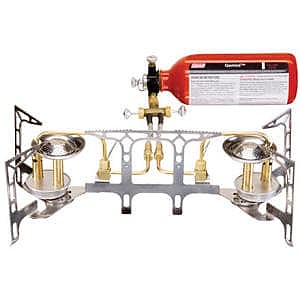Coleman Gemini Dual Fuel Stove
The Gemini Dual Fuel Stove has been discontinued. If you're looking for something new, check out the best liquid fuel stoves for 2025.

Review: Coleman Gemini Stove, Dual Burner, Dual Fuel
Initially, the user will have to get acquainted with how the stove responds to the control. There are three controls that fuel stream passes through to each burner. One main valve at the pump controls the fuel supply to both burners. Then the fuel supply splits into two at the brass conduit divider, and one each control valve for each fuel line. Then one each control at the burner control. There are altogether 5 controls.
It is not difficult to flood the burner. It takes some getting used to, in order to start the burner without flooding it. The fuel control valve at the burner has 180 degree range. All the way to the left is for lighting position; all the way to the right is the minimum flame. The “on” position, or max fuel output, is achieved at roughly the mid range of the control valve. At the lighting position, the air inside the fuel bottle will escape with fuel, in order to aid the combustion and preheating. The user will need to replenish the air pressure, once the burner is properly heated and produces the blue flame.
Preheating is done by allowing the mist of fuel into the mixing chamber, and then out through the burner. Once the burner is ignited, the heat from the flame will allow liquid fuel to gasify within the brass generator. It is recommended to light one burner at a time, for an inadequate air supply to the burners could botch preheating.
The burner fuel control does not evenly increase the fuel supply. Somewhere at midpoint of turning the wire knob, the flame bursts open suddenly to max, when the cleaning needle is withdrawn into the generator tube. Until then, the control valve gradually increases the flame from the lowest setting, albeit minimally.
The burner fuel control does not shut off fuel completely. At the lowest setting, the burner will burn at the minimum flame—suitable for simmer or warm up. The user needs to shut off the main control valve at the pump, or the control valve at the brass divider conduit that supplies fuel to individual burner.
The flame strength at max is more than adequate to bring a quart of water to boil fast. One thing that is left wanting is the build-quality of the Coleman-proprietary pump unit. Besides the negative point of being limited to the use only with the Coleman brand fuel bottle, there is not enough “meat” to the flange that covers the fuel bottle’s mouth. This is the point where the fuel, that is kept under pressure inside, could leak out. Repeated stress against the flange, in order to form a tight seal, might cause a crack over a prolonged usage. Once this happens, it will render the stove useless, until the pump unit is replace.
I wished that Coleman added more material to the pump plastic and made it heavier-duty. Or, more desirably, modify the pump design, so that it can be interchangeably used with the metallic pumps that grace Primus Himalaya Series Omni Fuel or Multi Fuel stoves. But that is not going to happen.
The pump plunger is the same as those used in the green suitcase stoves. Only, there is no need to unscrew it, in order to pump air. Just close the hole on the pump head with the thumb. Don’t forget to let a few drops of oil into that pump cylinder.
Overall, the Gemini design is very good, well-built, strong yet lightweight. The stove gets 3.5, for the flimsy pump. Whether it will perform in the cold weather, however, is yet to be seen. One way to ensure its smooth start might be wrapping fiberglass around the burner stem and prime it with alcohol. That should heat the burner hot enough to keep the fuel vapor from liquifying before entering the burner.
Price Paid: $75
Don't ever buy one of these stoves. You can get it to run one out of ten times. It continuously floods and won't ignite properly.
Your Review
You May Like
Specs
| Price |
Historic Range: $104.83-$127.95 Reviewers Paid: $75.00 |


